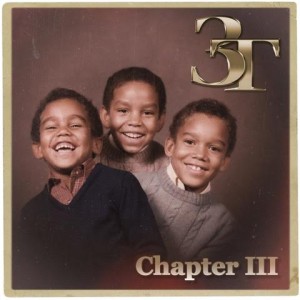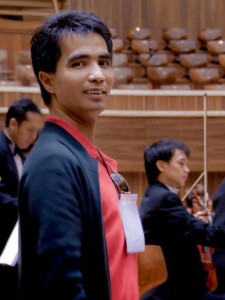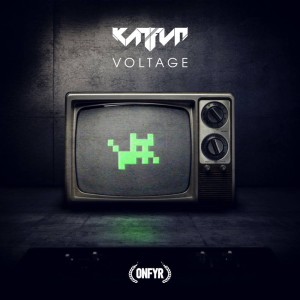Category Archives: Artist
Willem Rebergen, AKA Headhunterz, Chooses Studio One 3
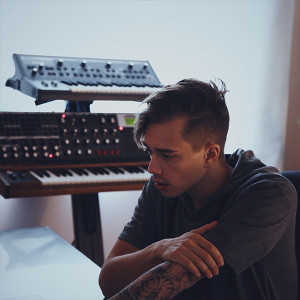 CNN recently reported that “Electronic Dance Music (EDM) is a $6.2 billion industry” and “the fastest-growing music genre out there.” Through cult-like followings on social media, hundreds of worldwide festivals, radio airplay, and collaborations with pop artists, EDM artists continue their foray into and beyond the mainstream.
CNN recently reported that “Electronic Dance Music (EDM) is a $6.2 billion industry” and “the fastest-growing music genre out there.” Through cult-like followings on social media, hundreds of worldwide festivals, radio airplay, and collaborations with pop artists, EDM artists continue their foray into and beyond the mainstream.
One of these artists is Willem Rebergen, better known to his 172,000+ followers on Instagram as DJ Headhunterz. Rebergen kicked off his career in 2006 as a DJ and music producer, and quickly grew into one of the biggest names in the industry, recently performing at several major festivals, including Electric Daisy Carnival and Tomorrowland.
After eight years making hardstyle music, Rebergen was ready to tackle a new challenge. “Right now I’m translating my signature sound to something a bit different from what I used to do but I don’t necessarily want to settle in a single genre anymore,” he states. “I want to feel free to go where my heart wants to go. Everything changes—and so does my personal taste, so listening to that is the only way for me to keep tapping into my full creative potential. Who knows what I might make tomorrow?”
We recently chatted with Rebergen about where he wants to take his music, his creative process, and working with Studio One. “I have been using Studio One for about two and a half years now and I am currently on version 3,” Rebergen states. “I make EDM, so I would say I use Studio One for composing and sound designing. I basically use it for anything necessary to produce a song.”
A longtime Logic user, Rebergen was turned on to Studio One by a recommendation of a very wise friend. He was immediately hooked. “I had been on Logic for years, but became unsatisfied with the lack of development of the software since Apple bought it. I felt it got behind compared to other more forward-thinking companies making DAWs,” he asserts. “I tried Ableton but that wasn’t exactly what I was looking for either. I was excited to give Studio One a go—I’m always eager to test new software, I’ve always been kind of a nerd, honestly. Looking for the next thing that improves workflow or sound quality. Studio One immediately felt natural to me, it really didn’t take me long to get used to, and I think especially for people coming from either Logic or Cubase it will feel very intuitive right away.”
“When I started using Studio One, I was very happy to feel back in control of my audio editing. The cutting tool felt very “direct,” and I loved the slip editing tool which I didn’t have before. Automation was as tight as it could get, and very quick and convenient—which was also one of the reasons for my switch. That is how automation should be! When you make electronic music I often want to be very surgical with drawing in automation, and Studio One simply allows for this at all times, even under the pressure of latency-inducing plugins. Latency compensation is always on point!”
Another feature that made me fall in love with Studio One was Track Transform. It’s so much more flexible than in any other DAW that I know of, and opens up a whole new spectrum of working with content that otherwise would be literally frozen and untouchable.
“Furthermore, I have been working more quickly in Studio One than ever before. The browser changed my way of working completely, and motivated me to create a perfect personal library where all my hard work is stored and ready to put back into action. When I create a sound in a soft synth, I create a Musicloop by dragging it into my browser. This saves not only the synth preset, but also the MIDI sequence and effect Plug-ins. It even lets me play a preview when I select it in my browser, so I know exactly what I’m about to drag into my project. I could not think of a more convenient way to browse through my self-made sounds.”
“All of these functions have made it possible for me to feel much more creative while being in the actual creative process, and not being pulled out of it by having to search endlessly for that particular sound I’m looking for, or having to work around functions that are not doing what I want.”
“I also create a lot of macros to improve my workflow, I’m totally in love with the new arranger and scratchpad function which allows for me to be much quicker and intuitive when arranging my songs without making a mess.”
As a full-time producer, Rebergen’s working knowledge of Studio One runs deep. When pressed for workflow details, he’s much more open than many of his peers. “I recommend that Studio One users make full use of the Browser and the Musicloops,” he opines. “When I finish a song, I completely undress it and save all sounds I made in the form of channel presets, Musicloops, and audio files. With every song I make, my library expands—and whenever I’m in the creative process I can recall any sound I am looking for without having to get into sound designing or endlessly searching through sample libraries. I make sure that every sound I save in MY library is on point, so they rarely need a lot of tweaking to fit into a song and I can just get on with concentrating on the creative part.”
He’s also taken advantage of using other, prehaps modest applications in conjunction with Studio One to accellerate his already blazing workflow. “I keep an app open alongside Studio One called Sticky Notes. I type down all my newly-made key commands—yes, I constantly make new ones! I then force myself to use them all the time so they become a natural part of my workflow. Customizable key commands make everything so much quicker, and Studio One allows for using them for almost anything.”
“Studio One invites us to have the best workflow we have ever had,” Rebergen continues. “I can’t believe I had been able to keep up with making new songs in the total mess I was working in when I used Logic. With every update, PreSonus puts out come fantastic new features which shows that the team is eager to keep pushing forward. They actually listen to what users want, and notice what users have been missing out on while working with other software. Coming from Logic, Studio One it gave me much better audio editing, better automation, more overview, a better overall workflow. I could keep going…”
And going he is. Rebergen has his hands in a lot of different projects apart from his own. “Currently, I have a collaboration out with R3hab called “Won’t Stop Rocking” on Spinnin Records. Other songs I have released this year are: “Live Your Life” with Crystal Lake and “The Power Of Now” with Steve Aoki. And, of course, some solo tracks, as well.”
Rebergen closes with a shout-out to the PreSonus krewe. “Team PreSonus has the perfect mindset to create the perfect DAW. In my opinion it already is the best DAW out there, and it’s going to get even more awesome, I’m sure. I’m beyond grateful to have Studio One in my life!”
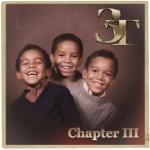
Taryll Jackson Chooses Studio One 3 Professional For New Album, Released Today!
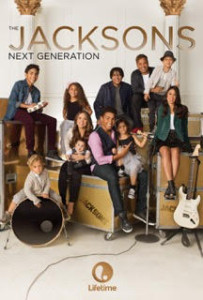
Passion for music and the last name Jackson go hand in hand. For Taryll Jackson, this passion is fueled by surrounding himself with his loving family, trusting his creative instincts, and utilizing a tool that will not slow down his process. That tool, among many, is PreSonus Studio One 3 Professional.
We recently heard about Jackson’s use of Studio One via Twitter. Flattered, we found it fitting to allow him more than 140 characters to share his thoughts on Studio One.
“I use Studio One 3 for everything,” Jackson reports. “Recording, composing, sound design—I’m using it in my home studio and with my mobile rig. I also use two FaderPorts, an HP60, an ADL 700, a FireBox, and a Central Station.”
Jackson is not stranger to working with multiple DAWs, and when he gives his reasons for choosing Studio One, he’s speaking from experience. “I’ve used pretty much all the DAWs,” he says. “In my opinion, Studio One was built from the user’s point of view and not from a programmer’s. It works exactly how writers, producers, songwriters, engineers would want it to work. I noticed with each DAW it was like they specialized in either audio or MIDI, but not really both. I was looking for a one-stop shop, something that could handle both sides but was also stable. I didn’t want to switch between programs, and most importantly, I wanted to feel inspired to create and get my ideas down as quickly as possible without the software getting in the way.”
When asked what Studio One features he finds most useful, Jackson’s obvious choice is drag and drop. “I think that drag and drop alone saves me so much time. When I’m creating, I don’t want to stop and set up bus channels, auxiliaries and routing. I don’t want to have to search for a plug-in through nested folders and sub-folders; I want stay focused on what I’m trying to create! Being able to drag a Reverb or Delay to a Send and having Studio One do all the work for me keeps my mind where it needs to be—on the idea. What takes other DAWs five steps, Studio One does in two steps—and sometimes one!”
“I can write a song in any DAW and I can produce a song in any of them,” Jackson continues. “For me, it’s about the process, the ease of flow. Studio One is going to work with me and help me get to the finish line quickly. It’s going to be fun and easy. I’ve had sessions with 240 tracks and Studio One still runs flawlessly. With other DAWs, I can’t have that many audio tracks, or it struggles and gives me errors. Studio One is tough to beat.”
Clearly, efficiency and flow are the order of the day in Jackson’s studio—he notes an oft-overlooked feature of Studio One that makes it uniquely his; customizable key commands. “I’m really big on key commands. I set them up the way I like, so I can fly. I believe you have to make it yours. Do what works for you—there is no right or wrong way, there’s just your way. What I love about Studio One is there are so many different ways to get to where you want to go. I think it’s the easiest and most powerful DAW out there. It works with you and your creativity, and not against it.”
The ever-driven Jackson has no plans on slowing down anytime soon. He’s currently working on a solo project, collaborating with other artists, and he and his brothers’ group 3T finished their third album, Chapter III, which is available today! The whole album was recorded on Studio One. Check out their song Fire below.
You can watch it all come together on the docu-series The Jacksons: Next Generation on Lifetime which airs its season finale November 6th.
Jackson closes with some kind words for the PreSonus crew—and the extended forum family.
“Love the company. Love the software. Love the forums and users. I’m excited about the Studio 192 and the new speakers. Studio One is definitely heading in a promising direction.”
“Fire,” from Chapter III:
MUTEMATH: On Tour With PreSonus and Dante!
MuteMath is a Grammy-nominated American alternative rock band from New Orleans that formed in 2002. Their dynamic sound combines moments of stillness with dance, hip-hop and pop beats. Paul Meany’s vocals make it a point to invade your personal space—his lyrics that continue to resonate with listeners for days after a listen.
Stubbornly refusing boredom or stagnation, MuteMath consistently lives on the cutting-edge of their craft, thanks to a creative work ethic—it’s safe to say that all of their work is their best work. After a short hiatus since their last studio album in 2011, MuteMath is excited to debut their fourth album Vitals, releasing November 13.
PreSonus recently partnered with MuteMath to take two newly Dante-enabled StudioLive RM32AI mixers and a StudioLive CS18AI on the road for their entire US Tour. In true MuteMath tradition—this was something of a rock’n’roll first.
Check out the video below to see what Paul had to say about taking an all-PreSonus mix solution on the road.
Click the image to the right to see how they’ve got everything hooked up. Dante makes it easy—imagine the difference between setting this up with a lightweight CAT5 cable as opposed to traditional, heavy, analog cables!
iCanStudioLive Multimedia Studio in Jakarta Chooses PreSonus for Full Solution
[This just in from Lucy Willar, Co-Founder of iCanStudioLive. She took the time to answer a Q&A from Laz Harris, our very own Asia-Pacific Sales Manager, to tell us a bit about what makes iCanStudioLive lead the A/V production industry in Jakarta—and how PreSonus is a part of it!]
- What is iCanStudioLive? What was the inspiration for the name?
Lucy: iCanStudioLive is the leading audio/video live recording producer in Indonesia. We produce quality content every day, and provide a one-stop solution from creative design to pre- and post-production and digital distribution. Our production team works very closely with quality talent to create unique programs to attract the global netizen. We’re located in Jakarta. Please feel free to visit our fully-equipped studio!
The inspiration for the name came from our ability to do everything at one place—integrated and digital. Once you enter our studio, you will immediately think, “I can do this! I can do that! I can do everything I want!” Also, coincidentally, our other founder, Irsan Wallad’s nickname is “Ican.” So it was a perfect match with his vision on live recording, too. Then we named our studio “iCanStudioLive”—all one word, please!
- What does your studio specialize in? Who do you cater to?
Lucy: We specialize in live recording, and help with concept and creative design for both audio and video. We are the first, and now leading the industry in live recording. We cater to skillful musicians, younger musicians, and prodigies. Case study: Joey Alexander, who is now becoming very popular in the USA.
- Who is iCanStudioLive? (your team, their roles)
Lucy: We have full team: A General Manager who takes care of all studio activities, a Program Manager who take care of all programs—existing and future ideas. We’ve also have a Creative Manager who takes care of production, and a Post-Production Manager who takes care of post-production audio/video. Last but not least we have a two-person editor team, five production assistants for audio and video, general affairs, security, etc. All told, we are 16 people.
- Whose vision was it to start the studio? When did it start?
Lucy: It’s Ican’s vision. He started this dream 15 years ago while doing his own business in multimedia.
- Can you give us some information about why you have chosen the complete PreSonus solution over all of the available choices?
Lucy: PreSonus offers a single integrated control system for both live performance and recording.
- Can you give us an explanation as to how it’s all hooked up? Perhaps explain a bit about the wiring between the control room and studio and your basic signal flow?
Lucy: Capture 2.0 makes for easy multi-tracking and routing channels from the StudioLive to the DAW. For live use, we make heavy use of the Fat Channel in the StudioLive console mixer—it allows us to control Gate, EQ, and Compression when used for front-of-house. Furthermore, we can color the live sound with the StudioLive’s built-in FX. On the other hand, for studio recording—we need everything kept FLAT at the source, and the StudioLive’s clean preamps provide excellent clarity with no audible coloration. It’s great for both applications.
- Last but not least, perhaps some background on Ichan, how he got into audio, etc.
Lucy: Ican fell in love with music when he was nine years old, and got started with multimedia when he was 13. His parents worked at a multinational company (Mobil Oil) as a joint venture between Japan, Indonesia and US. After getting a degree in architecture, he started doing live recording in 2007, and was eventually invited to record the local Symphony Orchestra in 2011. He built iCanStudioLive in the same year. Now he’s recording almost every day!
Thank you Laz! It’s great to be one big family and we are looking forward to work closer for years to come.
Best regards,
Lucy Willar
PreSonus LIVE: Using Plugins Live with Nothing More now Available on YouTube
The guys in Nothing More tour with a StudioLive RM mixer, running their favorite plugins at their live shows. Here’s how they do it.
Learn more about StudioLive RM here
Get the acoustic version of “Jenny” here
.@NothingMoreRock’s Acoustic Performance of “Jenny” from PreSonus LIVE
Nothing More delivered this incredible performance of “Jenny” for our recent PreSonus LIVE webcast. Of course, they absolutely NAILED it.
Latest @BrianBotkiller Album, “In Case of Revolution,” Produced in Studio One and Available Now!
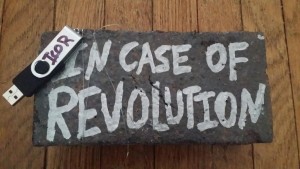 [This just in from PreSonus artist and good friend Brian Botkiller. His latest record was produced on a StudioLive and in Studio One!]
[This just in from PreSonus artist and good friend Brian Botkiller. His latest record was produced on a StudioLive and in Studio One!]
For my new record, In Case of Revolution, I tracked all my vocals and did all of my mixing in Studio One, as well as instrumental tracking. I began the record in the Studio One 2 era, but I finished the record in Studio One 3. I also mastered 52 songs in Studio One last year bfor a project I was part of called “Weekly Beats,” which challenged participants to write and release one song per week in 2014. I managed to finish the project, and Studio One was integral to that. It was so easy to take stems into Studio One, mix them, then go into the Project section to begin the mastering process. I built a template which I was able to start from, which made the whole process much easier.
Perry Sorensen, Head of Mastering at Naxos, Chooses Sceptre S8
[This just in from Perry Sorensen, Head of Mastering for leading classical music distributor Naxos of America! He’s chosen the Sceptre S8s as his new weapon of choice, and used them on the upcoming Live From Music City: The Best of Giancarlo Guerrero and the Nashville Symphony, which releases on August 14!]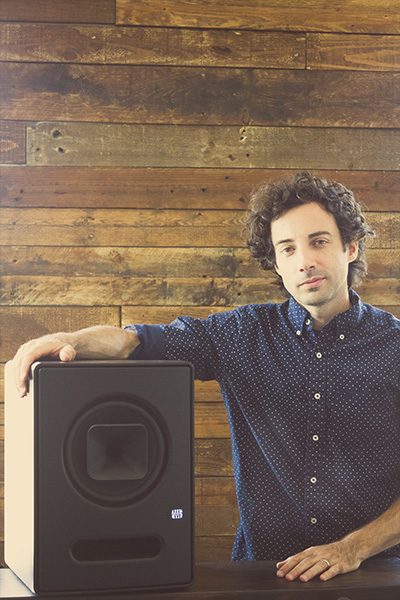
Q. Can you provide some background on Naxos of America?
A. Naxos of America is the leading independent classical music distributor in the U.S. and Canada. They specialize in state-of-the-art distribution and marketing and promotion. We distribute nearly 65,000 SKUs to traditional brick and mortar retail, as well as offering a comprehensive suite of services tailored to consumer direct fulfillment. Naxos of America is also one of the world’s largest digital distributors of independent classical music and video, supplying a catalog of over 1.6 million tracks and 65,000 album discs to hundreds of digital platforms and mobile outlets across the globe. We offer marketing, publicity, physical and digital e-commerce services, licensing opportunities, streaming services, sales support and customer service for all new releases and active catalog titles of Naxos Records and nearly 700 distributed labels. It’s a thriving company, and I really enjoy working there. We’re headquartered in Franklin, Tennessee, just a few miles south of Nashville.
Q. How did you become a mastering engineer?
A. I’d have to say it started out when I was in my teens. Like a lot of guys that age, I loved speakers…and bass! I think my affinity for audio was a bit different from other kids, because instead of listening to music and doing something else while listening, I would just sit myself in front of a home stereo system – the kind with the 10 inch woofers – and just listen. I would take it all in: the way the bass thumped in my chest and how the emotion of a song made me feel. What I didn’t realize was that I was actually doing critical listening, albeit an unprofessional form, but I loved it! Years later, I got my hands on some gear and started recording. One of the first things I did after getting some gear was to edit together entire soundtracks for shows for the performing arts. This included producing narrative pieces, as well. I actually met the girl who later became my wife, pop artist Jessie Kol, when I had the opportunity to record demos for her, when she was a vocal student at the performing arts center my family owned. It was around the time that I began working with my future wife that I realized audio engineering was my career “calling,” so to speak.
A few years later found me living and working in Nashville, Tennessee at one of the publishing arms of Universal Music Publishing Group. My time at Universal was fun, and it involved keeping track of their archives and also working in their studio, running sessions for dozens of songwriters and artists. Universal was where I learned how to “make a record.” The process of producing a record from start to finished was learned during my time there. I would also do engineering work on the side for various Grammy nominated producers, which landed me some credits on a few major label recordings. Throughout working as a recording and mix engineer, and producing a couple EP’s and countless demos for my wife, I was always fascinated with the “art” of mastering. “How do they make it ‘sound better’?” “Does the mastering phase give a recording that ‘punch’ and ‘wow’ or is it the mixing phase, or a combination of both?” Those were all questions that I researched long and hard to find out. In my quest for the answers I learned so much about mastering – what it can do, and what it can’t do.
Mastering seemed like an ideal fit for me for several reasons. I enjoy critical listening—just ask my wife how often I interrupt our conversation to say “do you hear that?” I love music and music production. And I enjoy making things sound “that much better.” There’s a thrill to lending your skill set and wisdom to a creative project in order to help make it all that it can be. You know, bringing out that potential and making it sound that much better. Naxos of America has been a great place for me to practice the art of mastering, by helping them and the labels they distribute to produce a great recording. It’s a fun environment. It doesn’t feel corporate to me. And I’m thankful to have been given a place like Naxos of America, whereby I can master some great music. There’s always plenty to do at Naxos, because we distribute a lot of music globally.
Q. How did you come about to selecting Sceptre S8s? Was it the company’s reputation, audio quality, specific features, price, other factors?
A. I first saw the Sceptres in TapeOp Magazine. The first thing that caught me was their unique design. Realizing that they were coaxial and time-aligned, I immediately began wondering how in the world PreSonus was pulling that off, and at that price point. I started thinking of how I could get my hands on a pair! A few months down the road, I decided to reach out to PreSonus, and hear for myself what the hype was about.
Q. Have the Sceptres met your expectations?
A. I have to say that before they arrived, I was a bit nervous about hearing these monitors and being disappointed. Not because I’ve heard anything bad about PreSonus, but because I was wondering if they would really deliver, and if they didn’t, how was I going to politely tell PreSonus that I didn’t like them. Haha. Almost immediately, though, I was blown away. An engineer friend of mine, who is also a co-worker, and myself set them up for an A/B session in our company’s listening room. Right away he said that the Sceptres were “punchy.” We were both so excited about them that we brought in our other co-worker, who’s also an engineer. He too, was very impressed with the transient response they have.
The Sceptres are punchy, but when I say “punch,” I’m not referring to bass. I’m referring to the mid, upper-mid, and upper frequencies. The transient response amazed us. Side by side with the competition (who shall remain anonymous, but be assured, was not at all a shabby monitor) – which was an audiophile 8 inch design with air motion tweeter – the transient response, depth, and clarity were obvious. We were playing some classic R&B songs, and instruments that were getting masked over by the competition’s monitors were clearly and beautifully represented by the Sceptres! The difference was night and day! And yes, the Sceptres represent the low end quite well. There’s no disappointment there.
Q. Now that you have been using the S8s for awhile what do you find special about or that you have come to appreciate (regarding frequency response particularly, with how the midrange frequencies are represented, detail, channel spread, etc.,)? What do you notice in the coaxial delivery?
Put a different way, what features have proven particularly useful and why?
A. As a lot of engineers know, the mid-range frequencies are where the definition, the nuance, the texture, of any audio piece lives. The Sceptres have completely blown me away with how they lay open to expose every little nuance and detail of the music I master, whether it’s classical, jazz, or even a country album. Every instrument comes through. I honestly cannot over emphasize how the Sceptres really shine in allowing me to hear every bit of vital mid-range information. They don’t hype. They simply, effortlessly, and accurately reveal everything that’s there. That in turn, allows me to make any fixes and adjustments that need to be made so Naxos can give the client the best results. Seriously. Listening to the Sceptres is enjoyable. I can’t quite explain why, but the word I would use to describe how the Sceptres reveal the music to the listener would be “effortless.”
Q. Did S8s replace other speakers?
A. Yes!
Q. In the box, or out?
A. My mastering needs allow me to stay primarily ITB (in the box). I enjoy the workflow that being ITB allows.
Q.You mentioned that the S8s are extremely accurate and that it’s hard to believe so, at their price point. Could you embellish that statement?
A. Like I said, it’s amazing what PreSonus has packed into these monitors. I’m still trying to figure out how they’ve come up with such an offering at this price point. They’re not cheap, but they sure are a lot less than I’d expect to pay for something that offers this level of accuracy and imaging.
Q. Any user tips or tricks or interesting stories based on your experience with? Any war stories you want to share?
A. One thing that I’ve realized about any craft, is that it’s not so much about the tools, but about the person using the tools. Sure, tools are important, but I think in the audio field we’ve gone overboard in believing that simply having the grand converter or pre-amp is what makes a recording sound incredible. I believe that having great gear is very important. But, when I began engineering, I learned how to make recordings sound great with a Mackie 1402, a NanoVerb, and standalone CD recorder. I would produce demos for vocalists. It turns out, they were impressed. That encouraged me to get my first DAW – the original MBOX with Pro Tools. Nothing ultra, but it’s what I was able to get. From there, I produced more demos for vocalists. One of the guys I created a demo for was so impressed that he told me my recording and mix sounded better than the demo that he had shelled out a bunch money for on Music Row a few years earlier. That, for me, was when I started realizing that it’s not so much about the tools, but the engineer – his ear, his understanding of what gives a recording “that” sound.
Again, high quality tools are definitely important, but what precedes that is the understanding and ability of the engineer. My take on it, is that a great engineer can make extraordinary use of minimal gear. Great engineering is also about process, just as much as it is about knowing your tools. There have been countless times when I’ve caught something that needed correcting, simply because the process I use in my approach to mastering a project was being used. In other words, it had little to do with the gear. I believe it’s crucial for an engineer to develop process – a protocol of how you approach and run through a project. Be thorough. Double check your work. Give a QA listen through of that disc or DDP master before you hand it off to the client. Make sure you really got the sequencing correct…for the 3rd time. If you notice something that may seem to be out of place, ask the client if that was their intent.
Q. Any interesting musical projects that you’ve mastered recently?
A. Yes! Definitely! Naxos is always getting interesting projects but aside from that, back in November, Naxos did a re-release of the acclaimed “Jazz at the Pawnshop” album that was recorded live in 1976 at the Jazzpuben Stampen (Pawnshop) in Stockholm, Sweden. That was a fun project to re-master. The history behind it and the fact that it was a re-release of the original 12 track recording made it to be a very exciting re-mastering project for me. Most recently, I’ve just wrapped up mastering a really cool project of the Nashville Symphony. Naxos has put together a “Best Of” project in partnership with the Symphony. It’s called “Live From Music City: The Best of Giancarlo Guerrero and the Nashville Symphony.” The Nashville Symphony and Naxos of America enjoy a great business and creative relationship and we’re both very excited to release this special project in August!
Here’s the details on the above mentioned release:
LIVE From Music City: The Best of Giancarlo Guerrero and the Nashville Symphony
Cat ID: 9.50141
Composers: Piazzolla; Sierra; Daugherty; Danielpour; Paulus
Artists: Nashville Symphony + Giancarlo Guerrero
Digital Release Date: May 5, 2015
Physical Release Date: August 14, 2015
About: Drawn from seven years’ worth of commissioning and recording projects, Live From Music City captures the full breadth of the Nashville Symphony sound, from Michael Daugherty’s pop-culture inspired tone poems to Roberto Sierra’s fiery, Latin-flavored symphonies. Hear an orchestra that’s truly in tune with its place and time, recorded live at the world-class Schermerhorn Symphony Center.
And here’s details on Ancient Voices, also recently mastered on the Sceptres.
Ancient Voices
Cat ID: 8.578311-12
Composer: Richard Danielpour
Artists: Hila Plitmann; Nashville Symphony; Giancarlo Guerrero; Pacific Chorale; John Alexander; Pacific Symphony; Carl St. Clair
Digital Release: June 2, 2015
Physical Release: June 9, 2015
About: One of the most sought-after and decorated composers of his generation, Richard Danielpour refers to himself as “an American composer with a Middle Eastern memory”. His distinctive voice is part of a rich neo-Romantic heritage which includes 20th century American and European composers alike. Darkness in the Ancient Valley, a symphony in five movements inspired by recent events in Iran, utilizes a wide range of Persian folk-melodies and Sufi rhythms. Toward a Season of Peace is an oratorio which explores violence and war in the name of religion, using the season of spring as a metaphor for change and transformation towards songs of peace through forgiveness. Danielpour’s insistence on music having “an immediate visceral impact” can be heard throughout his oeuvre, and the beautifully translated Persian poetry and rich spirit of harmony in Toward a Season of Peace make it symbolic of a brighter future for our time.
- Learn More about Sceptre CoActual Studio Monitors
- Learn more about Naxos in this recent Stereophile interview with their founder Klaus Heymann
- Get LIVE From Music City on iTunes here
Studio One 3 Launch: Los Angeles Studio Chat—Part 1 of 3
Studio One 3 Launched on May 20, 2015. Marketing Director Carl Jacobson sat down at Burbank, California’s Legend Studio with a panel of engineers, DJs, and producers including Sak Pase, AG, KATFYR, Chaka Blackmon, and DJ Faust to talk about why they’ve chosen Studio One over other DAWs.
Learn more about Studio One 3 and try the demo here: http://studioone.presonus.com/
.@KATFYR’s Latest Release, “Voltage,” Produced in Studio One, Available now on BeatPort
[This just in from KATFYR, who just released “Voltage“—produced entirely in Studio One! You can (and should) buy Voltage on BeatPort by clicking here. You can also listen to the track below, and check out the video interview to learn a few more details about his production tricks.]
My latest release, Voltage, was produced with Studio One 3 from start to finish. I got to take advantage of many of its newest features.
The new Arranger Track expedited the process of building the entire song structure. It enabled me to easily duplicate whole sections of the arrangement and move them around. The Scratch Pad enabled me to test how different sections interact with each other in order to find the best flow for the track.
I’ve also made good use of the new Effect Splitter feature, particularly in the bus channels for bass and synth sounds, where I was able to pinpoint certain frequencies and apply effects directly to those areas. It would nearly impossible to get the sounds I did using anything else!
